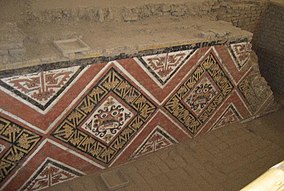Huaca de la Luna
| Huaca de la Luna | |
|---|---|

|
|
| Location |
|
| Nearest city |
|
| Coordinates | 8°8′5.93″S 78°59′27.40″W / 8.1349806°S 78.9909444°WCoordinates: 8°8′5.93″S 78°59′27.40″W / 8.1349806°S 78.9909444°W |
| Established | Mochica era |
Huaca de la Luna ("Temple/Shrine of the Moon") is a large adobe brick structure built mainly by the Moche people of northern Peru. Along with the Huaca del Sol, the Huaca de la Luna is part of Huacas de Moche, which is the remains of an ancient Moche capital city called Cerro Blanco, by the volcanic peak of the same name.
The Huacas de Moche site is located 4 km outside the modern city of Trujillo, near the mouth of the Moche River valley. The Huaca de la Luna, though it is the smaller of the two huacas at the site, has yielded the most archaeological information. The Huaca del Sol was partially destroyed and looted by Spanish conquistadors in the 17th century, while the Huaca de la Luna was left relatively untouched. Archeologists believe that the Huaca del Sol may have served for administrative, military, and residential functions, as well as a burial mound for the Moche elite. The Huaca de la Luna served primarily a ceremonial and religious function, though it contains burials as well.
Today the Huaca de la Luna is colored the soft brown of its adobe brickwork. At the time of construction, it was decorated in registers of murals which were painted in black, bright red, sky blue, white, and yellow. The sun and weather has since utterly faded these murals away. Inside the Huaca are other murals created in earlier phases of construction. Many of these depict a deity now known as Ayapec. Ayapec is a pre-Quechua word translating as all knowing. "Wrinkle-Face" is the name given to another deity by the later Inca because of the deity's appearance.
Many of the later bricks used in the structure bear one of over 100 different markings, perhaps corresponding to groups of laborers from different communities. Each "team" was maybe assigned a mark to put on their bricks, and these were used to count the number of bricks laid for financial as well as (presumably) competitive purposes.
...
Wikipedia
